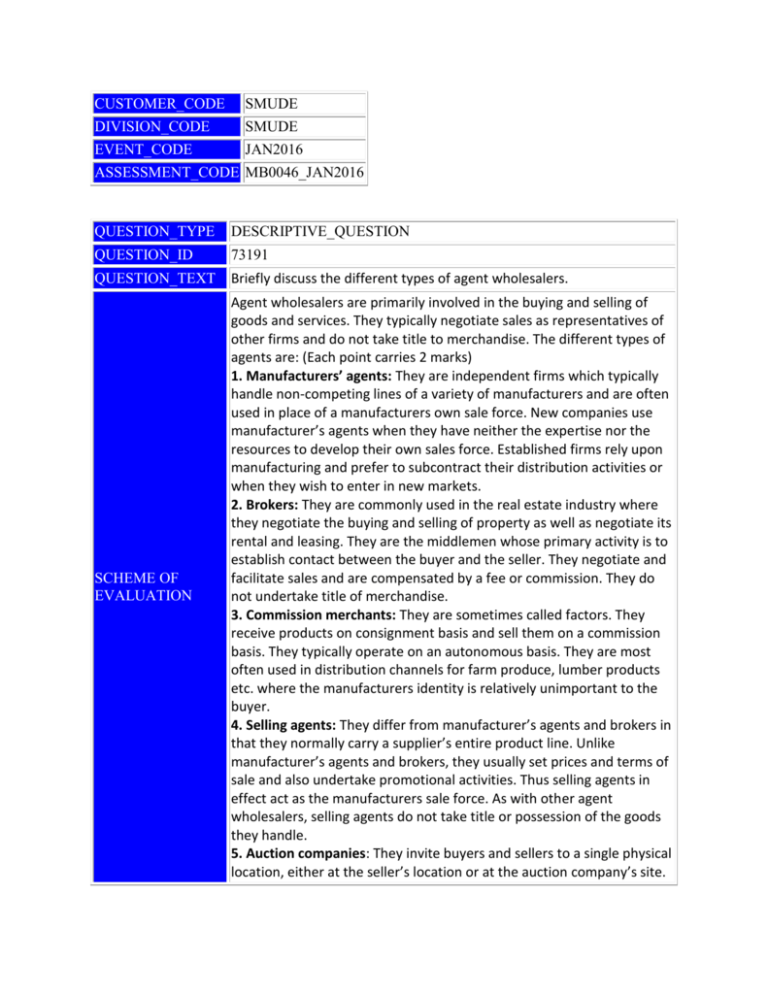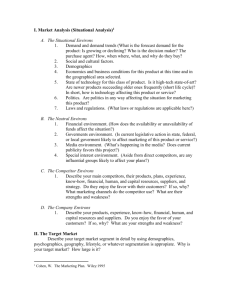CUSTOMER_CODE SMUDE DIVISION_CODE SMUDE
advertisement

CUSTOMER_CODE SMUDE DIVISION_CODE SMUDE EVENT_CODE JAN2016 ASSESSMENT_CODE MB0046_JAN2016 QUESTION_TYPE DESCRIPTIVE_QUESTION QUESTION_ID 73191 QUESTION_TEXT Briefly discuss the different types of agent wholesalers. SCHEME OF EVALUATION Agent wholesalers are primarily involved in the buying and selling of goods and services. They typically negotiate sales as representatives of other firms and do not take title to merchandise. The different types of agents are: (Each point carries 2 marks) 1. Manufacturers’ agents: They are independent firms which typically handle non-competing lines of a variety of manufacturers and are often used in place of a manufacturers own sale force. New companies use manufacturer’s agents when they have neither the expertise nor the resources to develop their own sales force. Established firms rely upon manufacturing and prefer to subcontract their distribution activities or when they wish to enter in new markets. 2. Brokers: They are commonly used in the real estate industry where they negotiate the buying and selling of property as well as negotiate its rental and leasing. They are the middlemen whose primary activity is to establish contact between the buyer and the seller. They negotiate and facilitate sales and are compensated by a fee or commission. They do not undertake title of merchandise. 3. Commission merchants: They are sometimes called factors. They receive products on consignment basis and sell them on a commission basis. They typically operate on an autonomous basis. They are most often used in distribution channels for farm produce, lumber products etc. where the manufacturers identity is relatively unimportant to the buyer. 4. Selling agents: They differ from manufacturer’s agents and brokers in that they normally carry a supplier’s entire product line. Unlike manufacturer’s agents and brokers, they usually set prices and terms of sale and also undertake promotional activities. Thus selling agents in effect act as the manufacturers sale force. As with other agent wholesalers, selling agents do not take title or possession of the goods they handle. 5. Auction companies: They invite buyers and sellers to a single physical location, either at the seller’s location or at the auction company’s site. In addition to bringing buyers and sellers together, auction firms promote the goods they handle and actively negotiate the sale of those goods. These wholesalers participate to a less degree in the other marketing flows, except for ownership. Their participation in a channel is typically limited to facilitating a transfer of ownership. These firms also play a key role in the marketing of some commodities such as tobacco. QUESTION_T DESCRIPTIVE_QUESTION YPE QUESTION_ID 126172 QUESTION_T Differentiate between selling and marketing concepts. EXT SCHEME OF Differences Between Selling and Marketing Concepts EVALUATION QUESTION_TYPE DESCRIPTIVE_QUESTION QUESTION_ID 126176 QUESTION_TEXT Discuss the bases of market segmentation. Bases for Segmenting Consumer Markets SCHEME OF EVALUATION Marketers use more than one base to segment the market and identify the target market. The method of segmentation will vary in a business- to-business market than in individual consumer markets. Following are the common bases of marketing segmentation. 7.6.1 Geographic segmentation This is the simplest form of segmenting the market. Here, the marketer divides the target market into different geographical units such as nations, states, and regions. He/she may decide to operate in one or more than one geographical areas. Segmentation of customers based on geographic factors is as follows: Region – Segmentation by continent/country/state/district/city. Size – Segmentation on the basis of size of a metropolitan area as per its population. Population density – Segmentation on the basis of population density such as urban/sub-urban/rural, etc. Climate – Segmentation as per climatic condition or weather. 7.6.2 Demographic segmentation While it is easy to find and group people living in one geographic location, there may be a large variation in their demographic characteristics. Since consumer needs, wants, and demand patters are directly linked with demographical variables, this method of segmentation is popular among marketers. Segmentation of customers based on demographic factors is as follows: Age (dominant factor) – The age of a person is one of the basis of segmentation. For example, the product segmentation is done by Titan according to different age groups of people. Titan designed a sub-brand, Fastrack. These watches are basically for young, vibrant, and cool outgoing young generation. While for older person and professional it has created the steel series watches, Sonata. Income (dominant factor) – Income level of a person is also a basis of segmentation. For example, Titan watches offered Aurum and Royale in the gold/jewellery watch collection with the price ranging between ` 20000 to `1 lakh for upper class segment. Titan offered Exacta range in stainless steel, aimed at resisting the rigours of daily life for the middle segment. This range offers 100 models with the price ranging between ` 500 to ` 700. Titan presented the Sonata range for the third segment. The price range was between ` 350 to ` 500. Purchasing power (dominant factor) – Purchasing power of the buyer is one of the significant basis for segmentation. Examples of various car segments on the basis of purchasing power are as follows: Budget car segment – This segment is the biggest in the Indian market. The entry level of this segment begins from ` 1.5 to 3 lakh. Maruti 800 and Omni are the leading players in these segments. The viewpoint of this segment has changed with the launch of Tata Nano with a price range of 1 lakh. Small car segment is another name for this segment. In Indian market, there is highest competition in this segment. Compact car segment – This segment lies among budget car and family car. The price range preference is between ` 3 to 4.5 lakh. Maruti Zen, Fiat Uno, Tata Indica, and Santro is some of the leading players of this segment. Family car segment – The buyer’s purchasing power in this segment is rather higher than the budget and compact car segment. The price range of this segment is between ` 4.5 to 6 lakh. Maruti Esteem, Daewoo Cielo, and HM Contessa comes under this segment. In India, cars that are sold under the head ‘budget car’ and ‘compact car’ do not meet their purpose, especially in terms of space shifts to ‘family car segment’. Premium car segment – The purchaser who wants a true world class luxury car comes under this segment. Price range of this segment is between ` 6 to 8 lakh. A few main cars of this segment are Ford Escort, Honda City, Mitsubishi Lancer, Audi 1800, Opel Astral, etc. Super luxury saloon segment – This segment consists of buyers who look for a real, super premium car. Some of the major cars of this segment are Mercedes Benz E229, E-250, Rover Montego, Audi 6, BMW. In Indian market, this is a small segment. 1. Occupation 2. Gender - Goods may be segmented for male and female 3. 4. 5. 6. 7. Family size Family life cycle Nationality Religion Education - Primary, high school, secondary, college, and universities Psychographic segmentation Other than the demographic methods of market segmentation, segmentation on the basis of psychography is another popular method among marketers. Psychographics is the study of lifestyle of individuals. It involves developing sub-group identification on the basis of psychographical characteristics. Lifestyle is a way of living. It reflects a person’s living as a combination of his actions, interests, and opinions. Behavioural segmentation In the case of behavioural segmentation, the market is divided on the basis of purchase decision and product or brand usage made by consumers. Dividing the market on the basis of variables such as use occasion, benefits sought user status, usage rate, loyalty status, buyer readiness stage, and attitude is termed as behaviouristic segmentation. Buyers can be identified according to the use occasion when they develop a need and purchase or use a product QUESTION_TYPE DESCRIPTIVE_QUESTION QUESTION_ID 126182 QUESTION_TEXT Explain the functions performed by marketing channels. 1. 2. 3. 4. 5. SCHEME OF EVALUATION 6. 7. 8. 9. 10. Buying (1 Mark) Carrying inventory (1 Mark) Selling (1 Mark) Transportations (1 Mark) Financing (1 Mark) Financing (1 Mark) Promoting (1 Mark) Negotiations (1 Mark) Marketing research (1 Mark) Servicing (1 Mark) QUESTION_TYPE DESCRIPTIVE_QUESTION QUESTION_ID 126184 QUESTION_TEXT What is retailing? Briefly explain the most important types of retailing? Retailing is the final connection in the marketing channel that brings goods from manufacturers to consumers. In other words, retailing is the combination of activities involved in selling or renting consumer goods and services directly to ultimate consumers for their personal or household use. Types Mom SCHEME OF EVALUATION and pop stores and kirana stores Department stores Discount stores Category killers Specialty stores Superstores and hyper markets QUESTION_TYPE DESCRIPTIVE_QUESTION QUESTION_ID 126185 QUESTION_TEXT What are the differences between Macro and Micro Environment? Macro Last in size Macro environment cannot SCHEME OF EVALUATION be controlled It is very unpredictable & highly uncertain Very complex in nature Micro Small in size Can be controlled Not very unpredictable & low in uncertainty It simpler It includes political, social, It includes customer, publics, cultural, technological, competitions, suppliers and demographic, economic, and intermediaries natural environment






